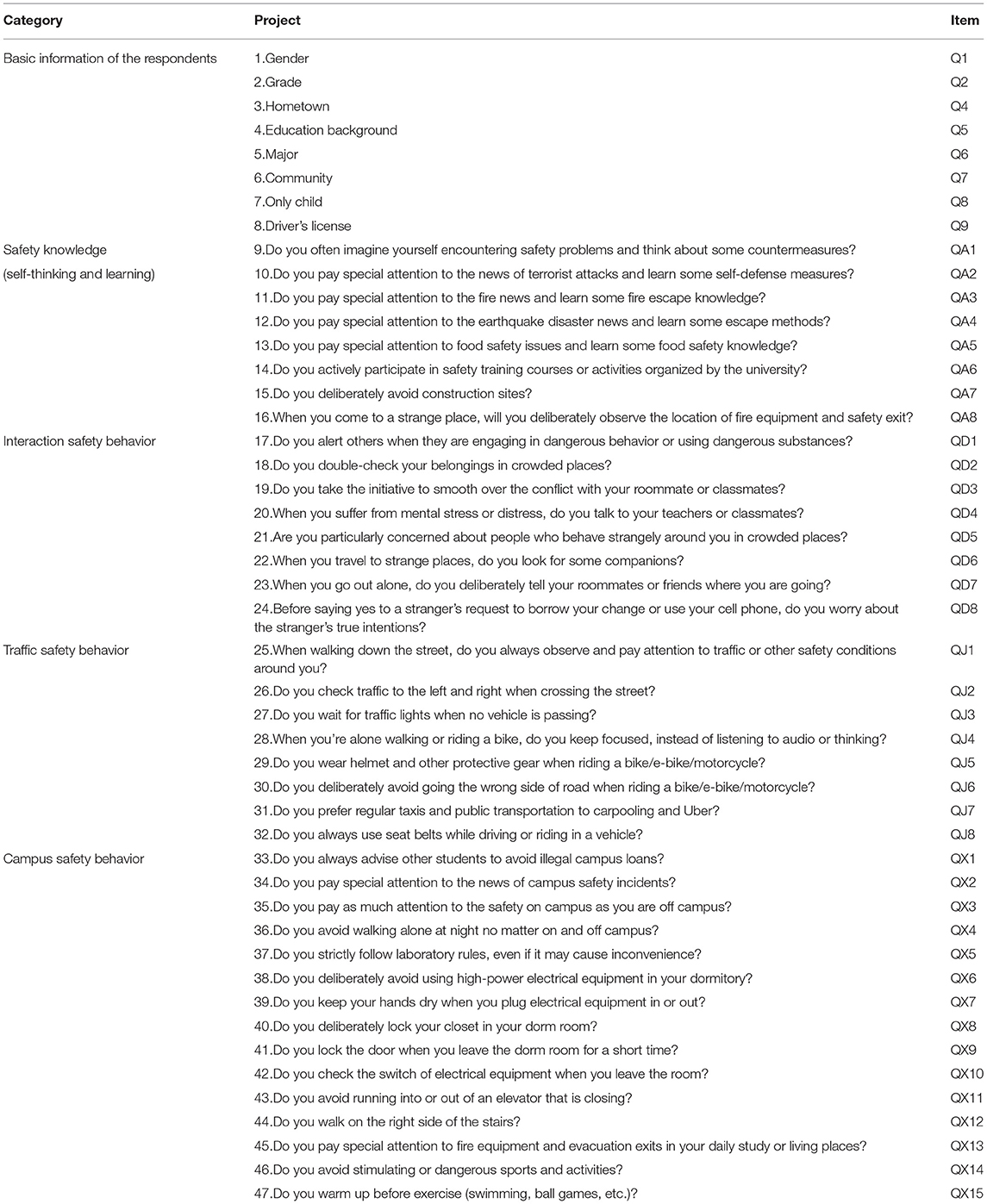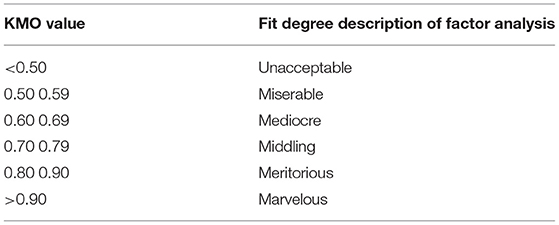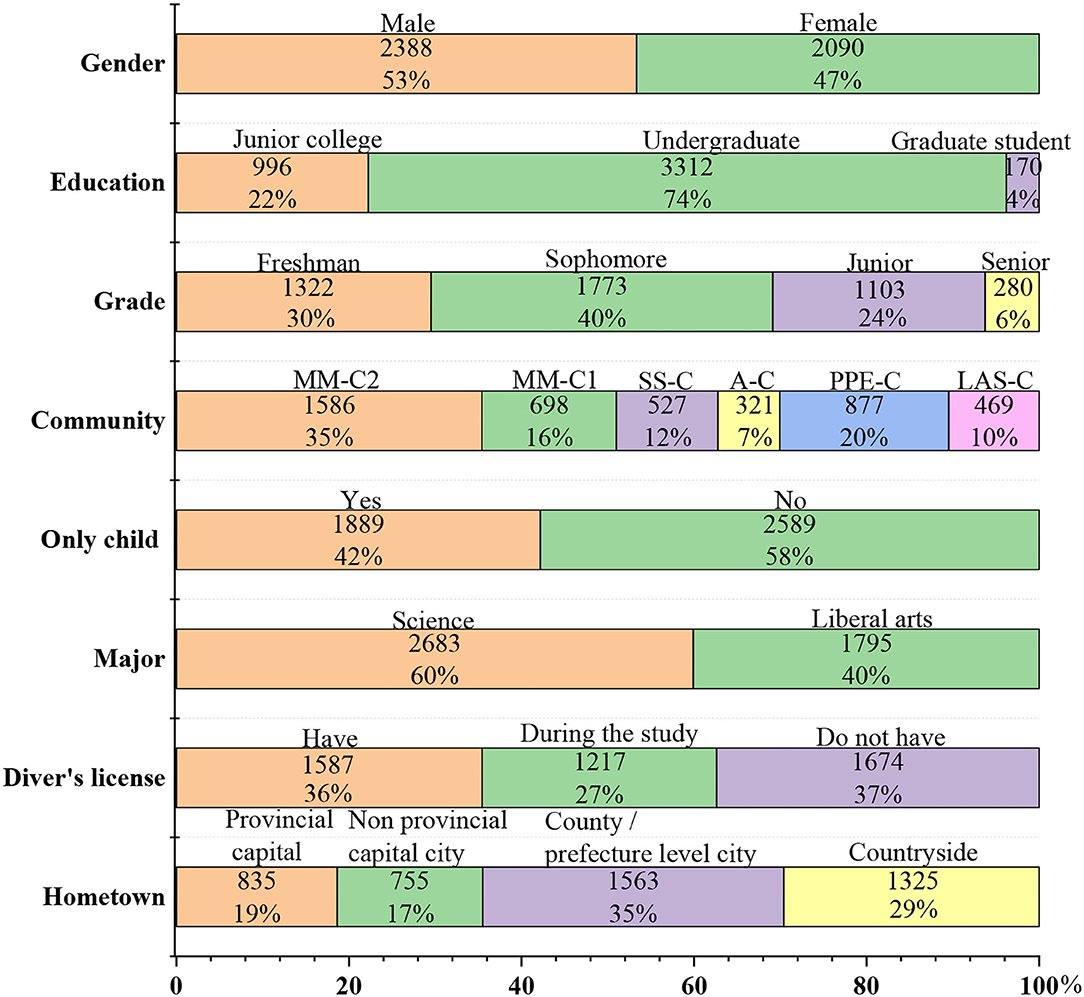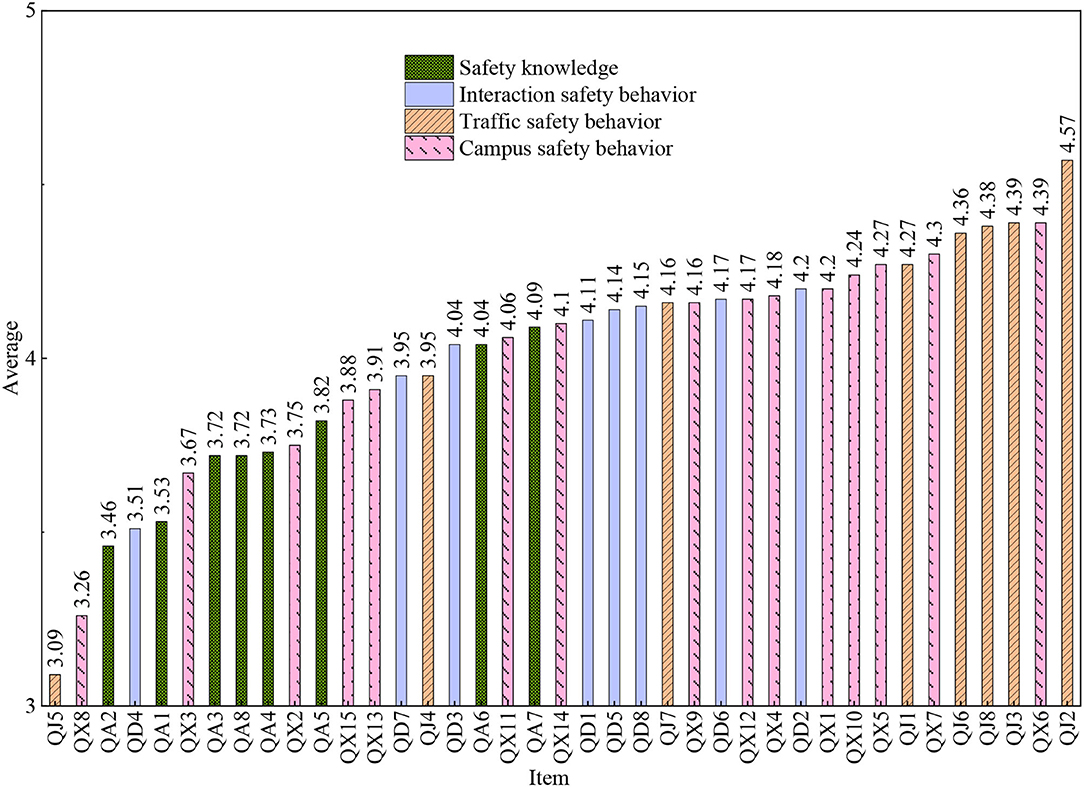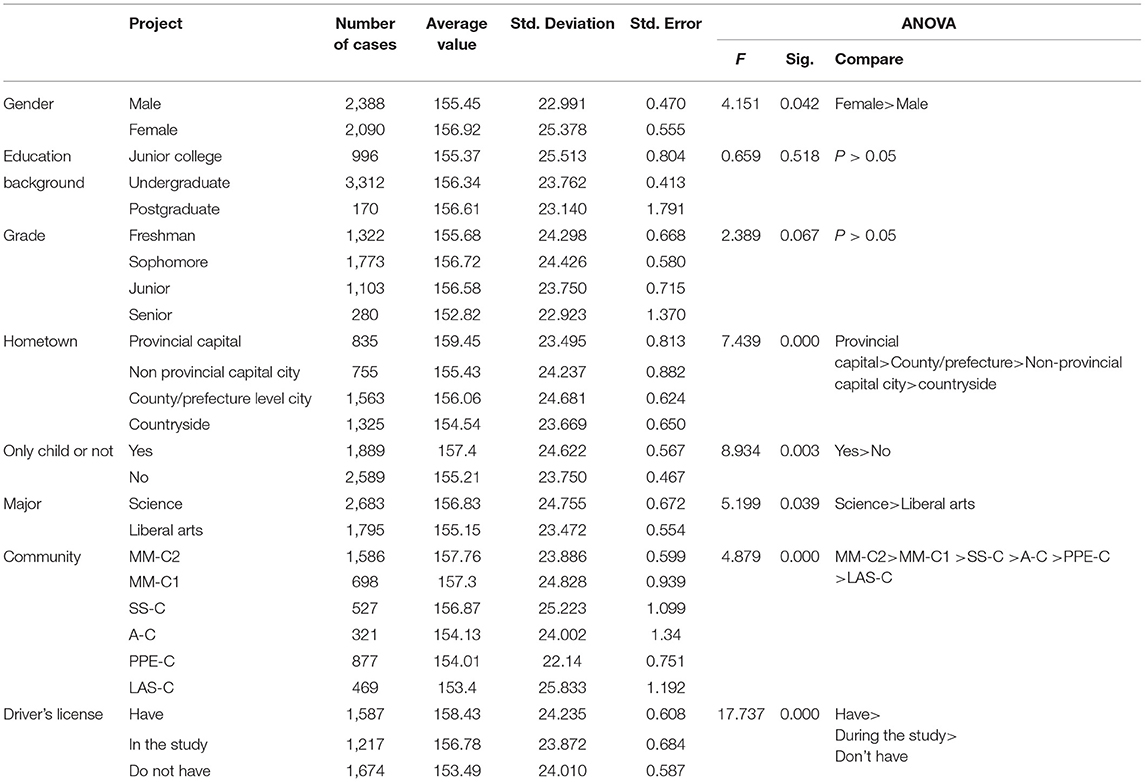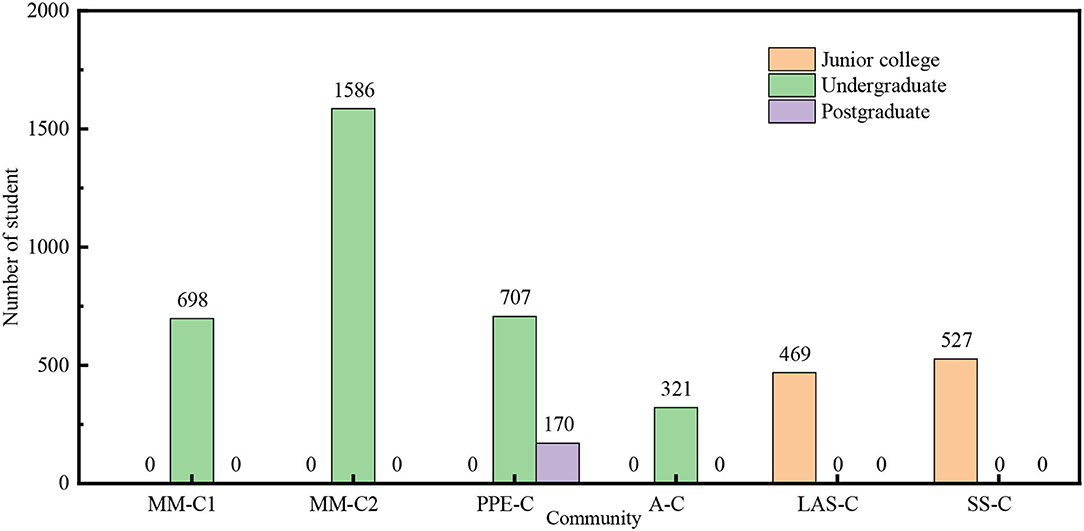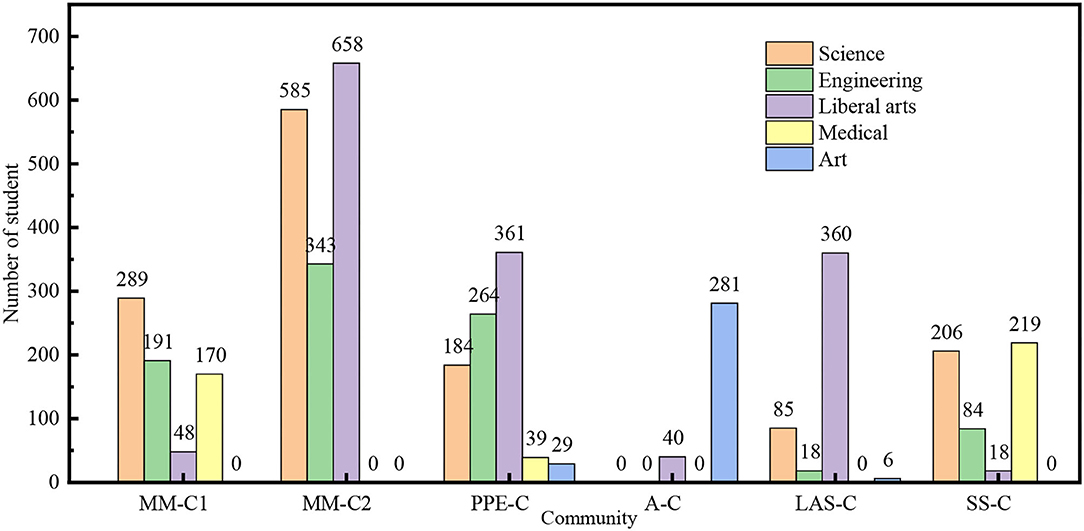- 1School of Civil Engineering, Xijing University, Xi'an, China
- 2School of Civil Engineering, Harbin Institute of Technology, Harbin, China
Relatively low level of safety culture among undergraduates and the imperfection of safety management system for students in university result in numerous safety problems. Researches on the safety culture of undergraduates in public universities are much more than those in private universities. Aiming to find out the potential and specific factors that affect the safety culture in the former are different from those in the latter, an anonymous questionnaire survey was conducted among 4,531 students in a private university in Shaanxi province, China. Gender, education background, grade, hometown, one-child policy, major, community, and driver's license on their safety beliefs and behaviors are treated as potential factors in the survey. According to the average score of each item, the investigated private university students are lack of safety knowledge, but perform well in traffic safety behavior. The results show that female students show better safety beliefs and safety behaviors than male students whilst the safety beliefs and safety behaviors of the student majoring in medicine is better than those of students in other majors. The students who live in more developed cities, who are from one-child family and who have driving license, show better safety beliefs and safety behaviors than others. The effective community system of mixed majors is conducive to the formation of good safety beliefs and safety behaviors of college students. The results highlighted that universities should formulate the corresponding intervention strategies to prevent safety problems of the college students according to the specific proportion of gender, major distribution and other actual situation.
Introduction
With an increasing number of students in universities and many complex factors leading to disasters, the cultivation of safety beliefs and safety behaviors has been getting increased attention in universities. However, at the present stage, relatively low level of safety culture among undergraduates and the imperfection of safety management system for students in university result in numerous safety problems. In recent years, many safety accidents in campus have been reported at home and abroad, such as dormitory fire (killing 41 undergraduates and injuring nearly 200 undergraduates in the dormitory building of Peoples' Friendship University of Russia in 20031), terrorism (killing 33 undergraduates and teachers in Virginia Tech which is the most serious campus shooting in the United States so far in 20072), lab explosion (killing one undergraduate and injuring four in a laboratory explosion at China University of Mining and Technology in 20153). These catastrophic accidents remind universities the importance of safety belief and behavior among the undergraduates.
Safety belief is the most basic idea to personal judgement in safety. Dong et al. (1) had made a classification summary of the accidents that occurred in universities from 2010 to 2015. The results show that the main factors that lead to safety accidents are the lack of safety belief. Jing and Wu (2) pointed out that the university students have a strong belief in safety, but their crisis awareness is relatively weak. Feng et al. (3) put forward the component relational network model using social network analysis (SNA) to improve the security management mechanism of universities. Yang and Li (4) identified the causes of safety accidents in universities through Systems-Theoretic Accident Model and Process (STAMP) accident model and process method.
Safety behavior depends on safety belief, but it is hard to turn safety belief into safety behavior easily. Walters et al. (5) pointed out that although students have a belief of safety, there are deficiencies in identification and emergency response when hazards occur, which need more guidance from universities to improve safety behavior of students. Wu et al. (6) and Qin (7) proposed that safety accident experience and safety training have practical significance on safety behaviors, and suggested that universities should carry out regular safety training to improve students' response ability. Li et al. (8) revealed various factors affecting safe behavior of college students. Thamrin et al. (9) concluded that many students working part-time off campus are prone to traffic safety accident. It should be mentioned that different from foreign universities studied by Thamrin et al. (9), most of the college students in Chinese universities live in campus. Reesi et al. (10) studied the risk driving behavior of students in Oman University, and concluded that it is necessary to integrate road safety into the field education.
At present, most of the researches on the safety culture of undergraduates are based on public universities. In the past decades, private universities in China have been developing rapidly, but still in their beginning stage. On the contrary, the number of the students in private universities of China is actually large. Relatively lower entrance threshold to private universities in China may lead to different safety culture level among the students, compared to those in the public universities. According to the statistical results of Wang and Wu (11), researches on the safety culture of undergraduates in public universities are much more than those in private universities. Moreover, the sample size of field survey on the safety culture of undergraduates is usually small.
Aiming to find out more potential and specific factors that affect the safety culture in Chinese private university and the difference between public university and private university with larger sample size, this study focuses on the safety culture (beliefs and behaviors) among Chinese undergraduates in a private university of Shaanxi province, which is the largest one in the northeast of China. The data is collected through anonymous online questionnaire survey. The correlation between the basic information and safety culture is by ANOVA and SPSS26 was used for data analysis. The reliability and validity evaluation are conducted through Cronbach's α and factor analysis, respectively. After analyzing the significant factors influencing the safety culture of private college students, some suggestions are made to improve the safety culture of private college students.
Methodology
Instrument
Before the formal investigation, the professors whose specialties involved safety education at universities and who acquainted with the research in safety culture area were invited to participate in the development of the questionnaires items. After the trial and first-run exploratory factor analysis, some the ambiguous and offensive items related to personal finances and religious belief were deleted. The items were guaranteed to not load at any factors or loading not exceed 0.4 in the factor analysis. Total 39 items related to the safety beliefs and safety behaviors of undergraduates were obtained as listed in Table 1, which include 8 items related to safety knowledge, 8 items related to interaction safety behavior, 8 items related to traffic safety behavior and 15 items related to campus safety behavior. A five-point Likert scale (1-Never, 2-Rarely, 3- Sometimes, 4-Most, 5-Always) was used to quantify the measurement of each item.
In addition, 8 personal basic information items of the undergraduates, including gender, educational background, grade, hometown, one-child policy, major, community, and driver's license, were collected through questionnaire to investigate how much the correlation between the basic information and safety culture is by ANOVA. SPSS26 was used for data analysis.
It should be mentioned that the community system is a type of management mode in universities. In the private university of this research, six communities were involved, including Major-Mixed community 1 (MM-C1), Major-Mixed community 2 (MM-C2), community preparing for the postgraduate entrance test (PPE-C), Art community (A-C), Liberal arts specialty community (LAS-C) and Science specialty community (SS-C). The last two are for junior college education.
Subjects
The survey was carried out in the largest private university in the northwest of China. Formal survey was conducted in the form of online questionnaire distributed randomly through mobile APP. The survey time was from June 1, 2020 to June 24, 2020. Four thousand five hundred and thirty-one online questionnaires were collected. According to the principle of 3σ and normal distribution, a total of 53 abnormal questionnaires with <70 s or more than 490 s answer time and most of the missing data were excluded. In that case, 4,478 valid questionnaires with an effective response rate of 98.83% were obtained finally. Table 2 shows the summary of questionnaire processing.
Reliability and Validity Evaluation
Reliability
Cronbach's α ranging in 0–1 (12) is used to measure the internal consistency reliability coefficient of the questionnaire items of the five level Likert scale. Cronbach's α could be described as Equation (1):
where k is the total number of items in the scale. is the intra-class variance of the score of the question i. is the variance of the total score of all items.
Table 3 shows the evaluation principles of internal consistency coefficient based on the research of Nunally and Bernstein (13) and DeVellis (14).
Cronbach's α of the questionnaire in this study is calculated through SPSS 26. It should be noted that 8 basic information items are not involved in the measurement of the scale and it is not necessary to conduct the reliability test and validity test of those items (15). As Table 4 lists, the Cronbach's α for 39 items in the questionnaire is 0.961, which is “Excellent” grades listed in Table 3 which indicates that the questionnaire in this study can be used for follow-up analysis.
Validity
Factor analysis is the most commonly used statistical method for validity evaluation. Before conducting factor analysis, Kaiser-Meyer-Olkin's Measure of sampling adequacy (KMO) and Bartlett's Test of Sphericity should be conducted in SPSS. The evaluation principles of KMO are shown in Table 5 (16).
Table 6 presents that the KMO value for questionnaire is 0.967, which is “Marvelous” grade listed in Table 5. The chi-square test value in Bartlett's test of sphericity is 111102.743 which is relatively large. The corresponding significance is 0.00 < 0.05 at which level, the original hypothesis can be rejected. It shows that the possibility of sharing common factors among items is low, which is suitable for factor analysis.
In the results of factor analysis, the main indicators used to evaluate the validity are commonality and cumulative variance contribution rate. If the commonality is >0.4, it is acceptable. The cumulative variance contribution rate is more than 50%, which indicates that the effect of factor analysis is good.
According to Table A1 in Appendix A, the commonality of items in the corresponding factors is >0.4, which shows that the extracted factors can well reflect most of the information of the original variables. According to Table A2 in Appendix A, the cumulative variance contribution rate of the questionnaire is 59.329% > 50%. It shows that the five parts of the questionnaire can extract most of the item information, which indicates that the validity of the research data is good.
Results
Figure 1 shows the basic information of respondents. In particular, regarding community, 16, 35, 20, and 7% of the respondents are MM-C1M (Major-Mixed community 1), M-C2 (Major-Mixed community 2), PPE-C (Community preparing for the postgraduate entrance test), and A-C (Art community), respectively, whilst 10 and 12% of the respondents are LAS-C (Liberal arts specialty community) and SS-C (Science specialty community) students, respectively. Basic information generally maintains a proportionate balance. As a result, the questionnaire which is effective and credible can be used for ANOVA.
Figure 2 shows that the score of the items related to safety knowledge in this study is low, indicating that the safety knowledge of the investigated students is not enough. QJ5 (Do you wear helmet and other protective gear when riding a bike/e-bike/motorcycle?) gets lowest scores in this research. This may result from that young people tend to find it inconvenient or uncomfortable to wear helmets. In the research of Blair et al. (17), up to 71% of the respondents did not wear helmets, however wearing helmets can reduce the risk of serious head injury by 85%. It is not only necessary for the government to improve the policies to punish the behaviors violating the road safety rules, but also to strengthen the safety culture norms of students, so as to eliminate the practice of engaging in unsafe driving. QX8 (Do you deliberately lock your closet in your dorm room?) gets the second lowest scores in this research. This may result from the fact that the overall safety environment of the investigated private university which runs closed campus management, is quite good. The respondents tend to trust their roommates. In addition, the respondents may also feel that locking their own closet will show distrustful gesture to the roommates. The reason for the third lowest score of question QA2 (Do you pay special attention to the news of terrorist attacks and learn some self-defense measures?) may be that the gun control and anti-terrorism policies of Chinese government are quite restrict, resulting in excellent social stability and environmental security in China. The fourth lowest score of QD4 (When you suffer from mental stress or distress, do you tell your teachers or classmates?) may be due to the fact that college students are commonly sensitive and vulnerable. They are unwilling to share their troubles with others, worried about being discriminated by teachers and classmates, instead of being understood, namely “mental health stigma problem”. It may also be that Chinese people are introverted and prefer to talk to their relatives. It is suggested that universities should strengthen propaganda to reduce mental health stigma problem among college students, letting them accept psychological counseling and establish correct cognition of psychological help (18, 19).
On the contrary, the respondents did better in the following items. The scores of QJ2 (Do you check traffic to the left and right when crossing the street?) and QJ3 (Do you wait for traffic lights when no vehicle is passing?) are very high. The popularization of traffic safety education in primary and secondary schools has played a good role in the safety behavior of college students. Meanwhile, it may be that when college students cross the road, they would be affected by the people around them who obey the traffic rules (20). The score of QX6 (Do you deliberately avoid using high-power electrical equipment in your dormitory?) from Chinese private university students in this study is high, whilst in the investigation of Hasan and Younos (21), the awareness of foreign students on electricity safety is very poor. This high score of QX6 reflects the good effect of the apartment management work on banning the use of illegal electrical equipment in Chinese universities. Certainly it is also possible that the students who answered the questions were afraid of being found to have violated this rule, and intentionally choose “always”. The high score of QJ8 (Do you always use seat belts while driving or riding in a vehicle?) may be due to the relevant laws on seat belts issued by China's transportation department, which force the front-row passengers to use seat belts. If not, they will be fined and even affect the validity of their driver's license. It can be seen that the mandatory traffic laws could directly affect the traffic safety beliefs and behaviors of people.
Discussions
SPSS26 is used for ANOVA and the results are shown in Table 7 (22). The results of ANOVA show that educational background and grade are without significant effect on the safety belief and behavior of college students (Sig. > 0.05), similar to the survey findings for the college students in United States from Blair et al. (17). In contrast, gender, hometown, one-child policy, major and driver's license have significant influence on the safety beliefs and safety behaviors of college students (Sig. < 0.05).
Regarding gender, it is found that female students show better safety belief and behavior than male students, which is consistent with the survey results among college students in United States from Crowe (23) and in Bengal from Hasan and Younos (21). This fact may result from the difference in the characteristic between female and male students. Universities should provide safety education in the ways that can attract the interest of male students, such as the mobile-phone application or short video production competition of safety education.
From the comparison of average value, the hometown differences of college students lead to the different in their understanding of safety knowledge and the ways of dealing with safety problems. Generally, the students from developed cities could receive a better level of safety education, not only resulting from the fact that their family are normally in a good financial status, but also more safety problems would be encountered in developed cities. These results regarding hometown are also consistent with those from Hasan and Younos (21).
Regarding on the one-child policy, the respondents from only-child families show better safety culture than those having sibling(s). Since most of the one-child families are in the city, the effect of one-child policy is kind of in accordance to the effect of hometown in the questionnaire. In addition, parents of one-child families would pay more attention to the safety education of their child.
Regarding major, it is found that the students who major in science and have more safety knowledge shows better safety culture than the students majoring in liberal arts. Gong (24) also believes that medical students who have more safety knowledge from their daily learning would show better safety beliefs and safety behaviors than other major students. Therefore, it is suggested that the university should strengthen the development and diversity of safety culture courses, so as to increase the safety knowledge of each student and effectively avoid safety problems.
The advantage of community system is to break the boundary of major, and strengthen the communication among the students in different majors and cultural backgrounds. As shown in Table 7, the safety culture of the students from SS-C (Science specialty community of junior college) is much higher than that of the students from LAS-C(Liberal arts specialty community of junior college), since medical students in SS-C account for the majority as shown in Figures 3, 4. MM-C1 (Major-Mixed community 1), M-C2 (Major-Mixed community 2), and PPE-C (Community preparing for the postgraduate entrance test) are all mixed major communities. The students from MM-C1 and MM-C2 show better safety belief and safety behavior than those from PPE-C. The reason may be that the education of PPE-C particularly focuses on the postgraduate entrance test, neglecting safety education. Obviously, the community management system has a significant impact on the safety culture of college students.
Regarding driver's license, students who have obtained driver's license get much higher score than others. Before the driving test, people usually have a weak understanding of the traffic laws and regulations. During the study for driver's license, the safety belief and safety behavior of people would be greatly improved by learning the traffic laws and regulations. It indicates that the study of safety knowledge is very important to the cultivation of safety culture.
Recommendations
Based on the analysis of the results, it is recommended that safety culture measurement should be conducted before freshman enrollment and repeated every year since then to improve the safety administration and education procedure for university students. A dynamically updated database for the questionnaire items should be also developed. Specific methods for improving safety culture should be adopted for specific students. In the development of intervention strategies to prevent safety problems of the college students, more attention should be paid to the safety culture cultivation of male students. Considering that the safety culture level of medical students is generally high, it is suggested that the general safety course should be strengthened and diversified in daily teaching. The community management system also should be optimized to give full play to its advantages in the safety culture cultivation of college students.
Even though this measurement deals with pretty large sample size and considers more factors which have never been reported in previous studies, such as Community, One-child policy and Driver's license, there are still some limitations of this study. The results of this measurement tool may show some deviation when it is used in more developed areas of China. After the abundance of One-child policy in China, this factor would show less and less influence on the safety culture of undergraduates.
Conclusions
In this study, 4,531 students from a private university in Shaanxi province, China responded to the questionnaire anonymously online. By means of ANOVA, the influence of eight factors including education background, grade, hometown, one-child policy, major, community and driver's license, on their safety beliefs and safety behaviors was studied.
According to the average score of each item, the investigated private university students are lack of safety knowledge, but perform well in traffic safety behavior. Gender, hometown, one-child policy, major, community and driver's license have significant influence on the safety beliefs and safety behaviors of the respondents, but education background and grade do not. Female student has better safety beliefs and safety behaviors than male student. Since medical students have received the training of safety culture in their daily learning, their safety beliefs and safety behaviors are better than that of other major students. The safety beliefs and safety behaviors of only child families and students who have obtained driver's license are better than those of others. Under the community management system, each community has different major composition and cultural atmosphere, which is conducive to the formation of good safety beliefs and safety behaviors of students. The results highlighted that universities should formulate the corresponding intervention strategies to prevent safety problems of the college students according to the specific proportion of gender, major distribution and other actual situation.
To sum up, university safety administration and education is the key mean to improve risk avoidance ability of the college students and enhance their safety beliefs and safety behaviors. Universities should strengthen the regular safety knowledge popularization and various disaster emergency drills to improve the risk avoidance ability of college students.
Data Availability Statement
The original contributions presented in the study are included in the article/Supplementary Material, further inquiries can be directed to the corresponding author/s.
Ethics Statement
Approval was obtained from the Ethical Review Board of Xijing University. The procedures used in this study adhere to the tenets of the Declaration of Xijing University.
Author Contributions
SG: investigation, writing—reviewing and editing, and methodology. FY: investigation and writing—reviewing and editing. FR: conceptualization. CC: data curation and writing—original draft preparation. All authors contributed to the article and approved the submitted version.
Conflict of Interest
The authors declare that the research was conducted in the absence of any commercial or financial relationships that could be construed as a potential conflict of interest.
Publisher's Note
All claims expressed in this article are solely those of the authors and do not necessarily represent those of their affiliated organizations, or those of the publisher, the editors and the reviewers. Any product that may be evaluated in this article, or claim that may be made by its manufacturer, is not guaranteed or endorsed by the publisher.
Acknowledgments
The project was supported by Scientific research project of Youth Innovation Team Construction (21JP138) which are gratefully acknowledged. Many thanks to all the students at the university for taking part in the assessment process.
Supplementary Material
The Supplementary Material for this article can be found online at: https://www.frontiersin.org/articles/10.3389/fpubh.2022.825106/full#supplementary-material
Footnotes
1. ^Chinacourt.org. The Death Toll from the Fire at the Peoples' Friendship University of Russia Rose to 41 (2003). Available online at: https://www.chinacourt.org/article/detail/2003/12/id/95301.shtml (accessed December 10, 2003).
2. ^CCTV.com. The Alarm Rings Again: Issues Brought About by the “4.16” Shooting on American University Campuses (2007). Available online at: http://news.cctv.com/world/20070418/102677.shtml (accessed April 4, 2007).
3. ^Sohu.com. One Dead and Five Injured in Laboratory Explosion at China University of Mining and Technology (2015). Available online at: http://news.sohu.com/20150408/n410930329.shtml (accessed April 8, 2015).
References
1. Dong JY, Ma CG, Fu G, Du C. Analysis and countermeasures for behavioral causes of university laboratories safety accidents. Exp Technol Manage. (2016) 33:258–61. doi: 10.16791/j.cnki.sjg.2016.10.065
2. Jing YJ, Wu Y. Investigation and practice on current situation of university students' awareness of laboratory safety. Exp Technol Manage. (2019) 36:251–67. doi: 10.16791/j.cnki.sjg.2019.05.059
3. Feng LY, Wang J, Zhang Y, Wang WK, Liu Y. Study on influence mechanism and safety management of unsafe factors in universities based on social network. J Saf Sci Technol. (2020) 16:156–61. doi: 10.11731/j.issn.1673-193x.2020.04.025
4. Yang FQ, Li W. Application of accident model and process in safety management of university laboratories. Res Explorat Lab. (2020) 39:285−32.
5. Walters AUC, Lawrence W, Jalsa NK. Chemical laboratory safety awareness, attitudes and practices of tertiary students. Saf Sci. (2017) 96:161–71. doi: 10.1016/j.ssci.2017.03.017
6. Wu TC, Liu CW, Lu MC. Safety climate in university and college laboratories: Impact of organizational and individual factors. J Saf Res. (2007) 38:91–102. doi: 10.1016/j.jsr.2007.01.003
7. Qin S. Research on influencing factors of social practice safety risk in colleges and universities. China Saf Sci J. (2021) 31:18–23. doi: 10.16265/j.cnki.issn1003-3033.2021.01.003
8. Li XR, Xu SC, Chen XB, Sun Q. Analysis of the influence factors affecting campus security based on SEM model. Comput Appl Chem. (2018) 35:910–9. doi: 10.16866/j.com.app.chem201811005
9. Thamrin Y, Pisaniello D, Stewart S. Time trends and predictive factors for safety perceptions among incoming South Australian university students. J Saf Res. (2010) 41:59–63. doi: 10.1016/j.jsr.2009.11.003
10. Reesi HA, Maniri AA, Kai P, Hinai MA, Adawi SA, Davey J, et al. Risky driving behavior among university students and staff in the Sultanate of Oman. Accident Anal Prevent. (2013) 58:1–9. doi: 10.1016/j.aap.2013.04.021
11. Wang B, Wu C. Safety culture development, research, and implementation in China: an overview. Prog Nuclear Energy. (2019) 110:289–300. doi: 10.1016/j.pnucene.2018.10.002
12. Cronbach LJ. Coefficient alpha and the internal structure of tests. Psychometrika. (1951) 16:297–334. doi: 10.1007/BF02310555
13. Nunally JC, Bernstein IH. Psychometric Theory. 2nd ed. New York, NY: McGraw-Hill Education, Inc. (1978).
14. DeVellis RF. Scale Development: Theory and Applications. 3nd ed. London: Sage Publications (2011).
16. Kaiser HF, Rice J. Little Jiffy, Mark IV. Educ Psychol Meas. (1974) 34:111–7. doi: 10.1177/001316447403400115
17. Blair EH, Seo DC, Torabi MR, Kaldahl MA. Safety beliefs and safe behavior among Midwestern college students. J Saf Res. (2004) 35:131–40. doi: 10.1016/j.jsr.2003.11.003
18. Wei XL. The Impact of Stigma on Psychological Help-Seeking Willingness. Soochow University (2017).
19. Guo T, Zhu YS. A study on stigmatization of College Students' psychological help seeking. China J Multimedia Netw Teach. (2019) 3:122−3.
20. Li ZY, Wang Y, Fang DH. Research and exploration of laboratory safety culture construction in university. Exp Technol Manage. (2021) 38:289–92. doi: 10.16791/j.cnki.sjg.2021.02.063
21. Hasan MK, Younos TB. Safety culture among Bangladeshi university students: a cross-sectional survey. Saf Sci. (2020) 131:104922. doi: 10.1016/j.ssci.2020.104922
22. Lu XG. Practice Tutorial for Social Survey Research Based on SPSS 20. Beijing: Posts and Telecommunications Press (2016).
23. Crowe JW. Safety beliefs and safe practices among college students. J Saf Res. (1995) 26:187–95. doi: 10.1016/0022-4375(95)00010-N
Keywords: safety beliefs, safety behaviors, private universities, Chinese universities, questionnaire
Citation: Gao S, Chang C, Ren F and Yu F (2022) Safety Culture Measurement Among Chinese Undergraduates at a Private University: Development and Validation. Front. Public Health 10:825106. doi: 10.3389/fpubh.2022.825106
Received: 30 November 2021; Accepted: 01 March 2022;
Published: 28 March 2022.
Edited by:
Rajnarayan R. Tiwari, ICMR-National Institute for Research in Environmental Health, IndiaReviewed by:
Siti Munira Yasin, MARA University of Technology, MalaysiaZulfiqar Ali Shaikh, Dow University of Health Sciences, Pakistan
Copyright © 2022 Gao, Chang, Ren and Yu. This is an open-access article distributed under the terms of the Creative Commons Attribution License (CC BY). The use, distribution or reproduction in other forums is permitted, provided the original author(s) and the copyright owner(s) are credited and that the original publication in this journal is cited, in accordance with accepted academic practice. No use, distribution or reproduction is permitted which does not comply with these terms.
*Correspondence: Fei Yu, NzY3ODc0NEBxcS5jb20=
 Shan Gao
Shan Gao Chen Chang1
Chen Chang1